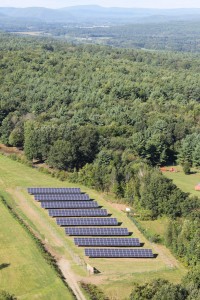By N. R. Mallery
The Putney Community Solar Garden

The Solar Garden’s Grand Opening on August 13, 2013. Pictured are panel owners, staff from SunFarm, Integrated Solar, the Clean Energy Collective and GMP.
The Putney Community Solar Garden went online August 23, 2013. It is Vermont’s first community-owned solar garden — a collaborative effort among SunFarm Community Solar, a Putney based solar organizer; the Clean Energy Collective, which handled financing, permitting, and legal matters; and Integrated Solar, a Brattleboro-based firm tasked with array construction.
The 144 kW project includes 576 Hanwha 250-watt photovoltaic panels, 24 Sunny Boy inverters and is mounted on a Schletter FS fixed racking system.
There are 49 Homes and businesses involved. From August 23 to October 24, 2013, the system produced 39,815 kWh of energy and offset approximately 62,000 lbs. of CO2 during this period.
Expectations
- This solar garden is expected to produce roughly 180,000 kWh of clean renewable energy per year.
- The expected payback is between 10.5 and 12 years.
- The system is expected to reduce carbon emissions by 280,000 lbs. per year based on the EPA average of non-baseload electricity generation emissions factor of 7.05 x 10^-4 metric tons CO2/kWh.
Projections
- Projected system lifetime: approximately 35 years
- Projected lifetime output: 7,650,000 kWh
- Projected lifetime reduction in power cost: $3,950,000
Future
Nick Ziter, owner of SunFarm Community Solar announced, “We’re working to develop three more projects of this size over the next year which will serve anyone in GMP territory, including former CVPS customers.” The community-owned solar gardens allow individuals, home and business owners, renters and non-profits a chance to own solar panels and receive all the same benefits as those with individual systems.
For more information on the Putney Solar Garden visit www.VTSolarGardens.com, email info@VTSolarGardens.com, or call (802) 536-4471.
Coyote Ridge Community Solar, Westford, VT
Coyote Ridge Community Solar – a community solar project for three households in Westford, Vermont – was completed in October, 2013. It was designed and installed by DC Energy Innovations of North Hero VT and Burlington. This ground-mounted system was installed using individual micro-inverters so that the system can be expanded easily in the future, as the participants find more people to join them. It is secured with custom-made ballast blocks because the soil was difficult to dig in. No foundations were necessary for the installation of the solar posts.
Manager Ben Gordesky, from DC Energy Innovations, said that “Community solar is a great way to go solar. The utility is required to divide up the benefits from the solar as the owners choose. In addition, the increased scale of a group project provides better economics (more benefit per dollar invested) and helps out everyone in the group!”
More info can be found at www.dcenergyinnovations.com or (802) 372-9514.
The 17.5 kW project includes 66 Solarworld 265-watt photovoltaic panels, 66 Enphase micro-inverters and is mounted on a Schletter PV Max fixed racking system.
From October 1 to December 3, 2013, the system produced 2,710 kWh of energy and offset approximately 4,036 lbs of CO2 during this time.
Expectations
- This community solar project is expected to produce roughly 20,400 KwH of clean renewable energy per year.
- The expected payback is approximately 10 years.
- The system is expected to reduce carbon emissions by 31,640 lbs. per year based on the EPA average of non-baseload electricity generation emissions factor, as above
Projections
- Projected system lifetime: 30 to 40 years.
- Projected lifetime output: 718,080 kWh
- Projected lifetime reduction in power cost: $215,000










Leave a Reply